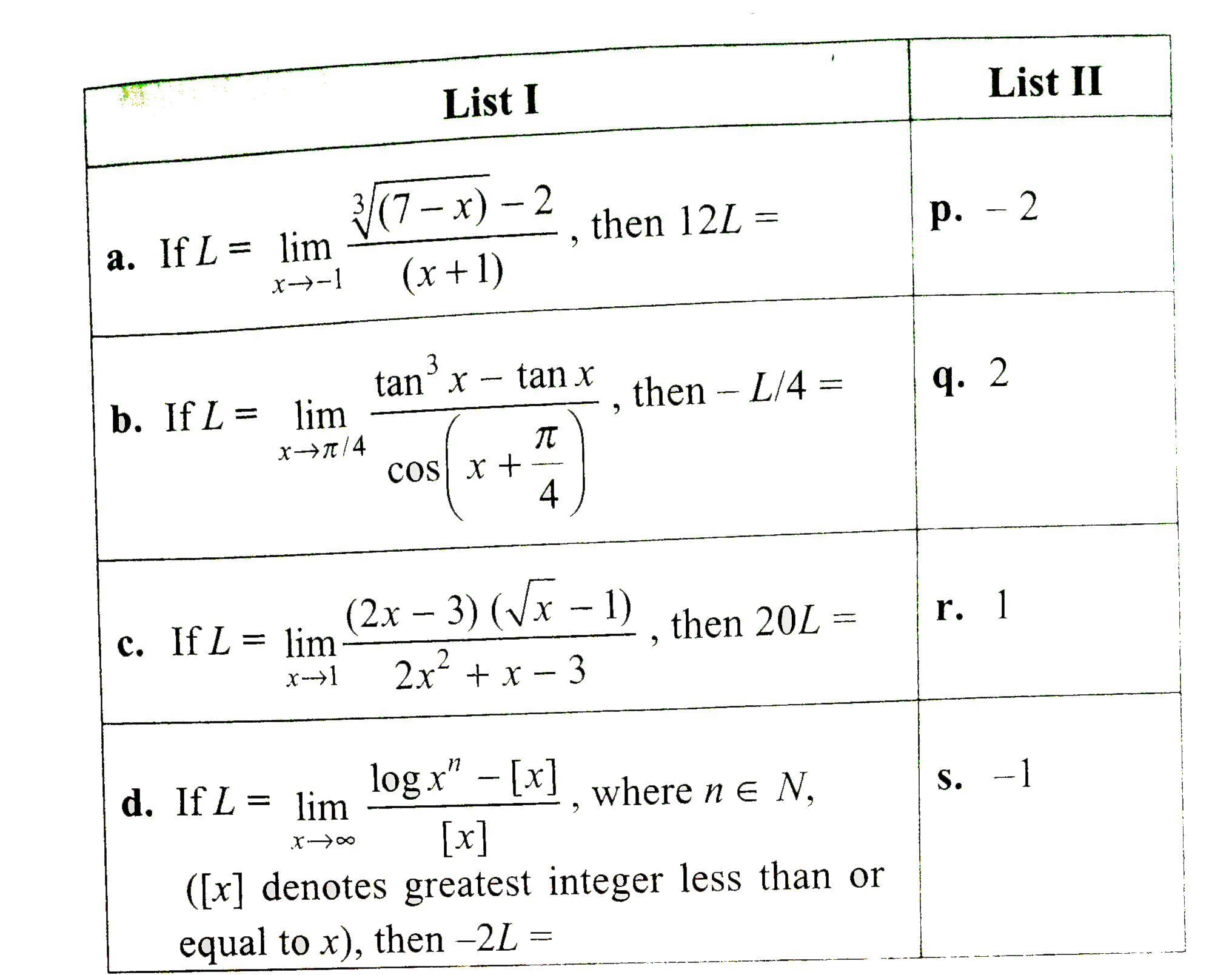Let f:R→R be a real function. The function f is double differentiable. If there exists n∈N and p∈R such that limx→∞xnf(x)=p and there exists limx→∞xn+1f(x) , then limx→∞xn+1f'(x) is equal to Solution in Bengali
The correct Answer is:D
We have limx→∞xnf(x)=p
⇒ limx→∞xn+1f(x)x=p
Using L'Hospital rule, we get
limx→∞(n+1)xnf(x)n+1f'(x)1=p
⇒ (n+1)p+limx→∞xn+1f'(x)=p
⇒ limx→∞xn+1f'(x)=−np
Further limx→∞xn+2f'(x)x=−np
Using L'Hospital rule, we get
limx→∞(n+2)xn+1f'(x)+xn+2f''(x)1=−np
⇒ −np(n+2)+limx→∞xn+2f''(x)=−np
⇒ limx→∞xn+2f''(x)=up(1+n)
Topper's Solved these Questions
- LIMITSBOOK - CENGAGE PUBLICATIONCHAPTER - LIMITSEXERCISE - Matrix Match Type
5 Videos
- LIMITSBOOK - CENGAGE PUBLICATIONCHAPTER - LIMITSEXERCISE - Numerical Value Type
26 Videos
- LIMITSBOOK - CENGAGE PUBLICATIONCHAPTER - LIMITSEXERCISE - Exercises (Single Correct Answer Type)
76 Videos
- JEE 2019BOOK - CENGAGE PUBLICATIONCHAPTER - JEE 2019EXERCISE - Chapter 10
8 Videos
- LINEAR COMBINATION OF VECTORS, DEPENDENT AND INDEPENDENT VECTORSBOOK - CENGAGE PUBLICATIONCHAPTER - LINEAR COMBINATION OF VECTORS, DEPENDENT AND INDEPENDENT VECTORSEXERCISE - DPP 1.2
10 Videos
Similar Questions
Match the following lists:

View SolutionThe reciprocal of the value of: limn→∞(1−122)(1−132)(1−142)(1−1n2)is
View Solutionlimx→0[sin(sgn(x))(sgn(x))], where [.] denotes the greatest integer function, is equal to
View SolutionIf y = y(x) is the solution of the differential equation, xdydx+2y=x2 satisfying y(1) = 1, then y(12) is equal to
View SolutionThe number of integral values of p for which (p+1)ˆi−3ˆj+pˆk,pˆi+(p+1)ˆj−3ˆk and −3ˆi+pˆj+(p+1)ˆk are linearly dependent vectors is q
View SolutionLet f:R rarr R be a positive increasing function with lim_(x rarr oo)(f(3x))/(f(x))=1 then lim_(x rarr oo)(f(2x))/(f(x))=
View SolutionLet f:R→R be a positive increasing function with limx→∞f(3x)f(x)=1.Then limx→∞f(2x)f(x) is
View SolutionThe function f(x)=lim_(n rarr oo n rarr oo)(x^(2n)-1)/(x^(2n)+1),n in N is identical with the function
View SolutionLet f(x)=lim_(n rarr oo)(cos x)/((1+tan^(-1)x)^(n)), then int_(0)^(oo)f(x)dx=
View SolutionLetf:R→R be a real function. The function f is double differentiable. If there exists n∈N and p∈R such that limx→∞xnf(x)=p and there exists limx→∞xn+1f(x),then
limx→∞xn+1f'(x) is equal to
View SolutionLetf:R→R be a real function. The function f is double differentiable. If there exists n∈N and p∈R such that limx→∞xnf(x)=p and there exists limx→∞xn+1f(x),then
limx→∞xn+2f''(x) is equal to
View Solutionमाना की f:R→R एक धनात्मक वर्धमान फलन है जिसके लिए limx−∞f(3x)f(x)=1. तब limx−∞f(2x)f(x)=
View SolutionLet f:R→R be a positive increasing function with limx→∞f(3x)f(x)=1. Then limx→∞f(2x)f(x)=
View SolutionLet f:R→[0,∞) be such that limx→3f(x) exists and limx→3(f(x))2−4√|x−3|=0. Then limx→3f(x) equals
View SolutionLet f be a function defined on R by f(x)=limn→∞log(3+x)−x2nsinx1+x2n then
View SolutionIf limx→∞f(x) exists and is finite and nonzero and if limx→∞{f(x)+3f(x)−1f2(x)}=3,then the value of limx→∞f(x) is
View Solution
